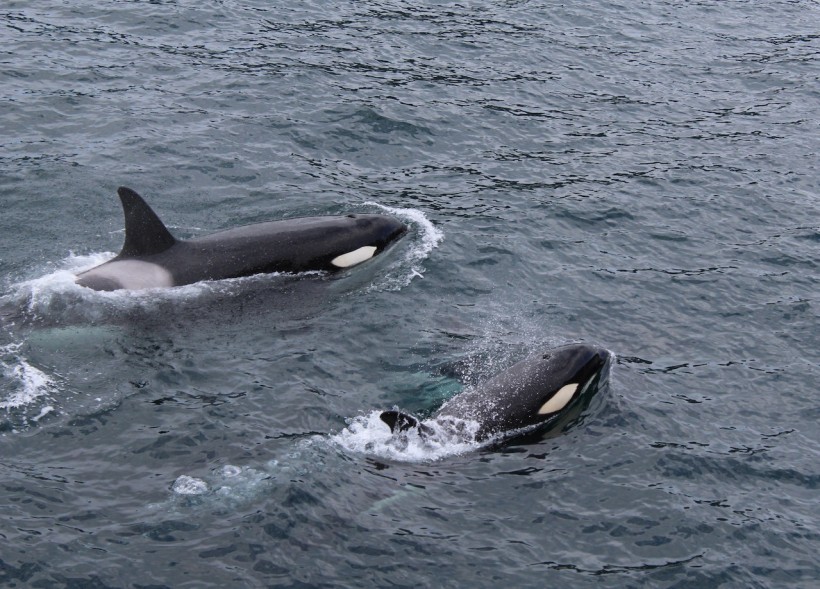While killer whales' diet and feeding habits have been a long-standing study subject, there is still so much mystery surrounding them. Now, a new study provides a new technique for getting a precise glimpse of the diet of these marine predators.

Orcas: Top Predators of the Ocean
As per Phys, these smart predators are known to harbor several techniques for hunting. This includes carousel feeding to cooperatively make waves that may dislodge seals from floes of ice. Because of this flexibility, orcas can hunt almost any marine species, from fish to blue whales.
While this largely depends on the creature's evolutionary history and location, several killer group whales have developed various ecotypes, which refer to their lifestyle and diet. Phys adds that the "most notorious ecotypes" are the resident and transient killer whales across the Eastern North Pacific.
Due to the creatures inhabiting very populated areas, such ecotypes have been extensive study subjects for several decades. This has allowed scientists to look into the species throughout the entire year.
Among such orca populations, scientists observed trophic cascades, which refer to how predator consumption affects the entire food web. These orcas largely affected kelp forest density. They reduced the population of sea otters, urging sea urchins to decimate and proliferate kelp forests.
Moving forward, initial studies proposed that there were two kinds of orcas: the ones that consume fish and seals from time to time and those that feed on mammals in the ocean. However, with the lack of supporting data and the emergence of evidence, scientists are proposing to retire this classification.
ALSO READ: Killer Whale Mothers Tend to Sacrifice Own Lives For the Sake of Their Offspring, Study Suggests
Determining What Killer Whales Eat
It is known to science that killer whales, or orcas, are the ocean's apex predators. While this is true, current understanding regarding the diet of these creatures is still not as comprehensive. This is especially true for remote orca populations, which cannot be looked at for the entire year.
Now, a new study has demonstrated a new way of knowing more about the precise diet of these creatures. The new technique involves analyzing skin and fat samples from orcas. The findings were included in the Journal of Animal Ecology.
As per the Whale Scientists, the researchers utilized a methodology known as QFASA (quantitative fatty acid signature analysis). This model enabled scientists to gauge how each species of prey contributed relatively to a predator's diet. The technique involves gauging the composition of fatty acids in orcas and their probable prey. By doing so, the scientists could estimate the precise proportions of various prey in the diet of these orcas.
To proceed, the researchers collected 200 skin and blubber biopsies. They then gauged the composition of lipids among 200 killer whales in the North Atlantic and more than 900 probable prey.
The researchers discovered how orcas have varying diets across the North Atlantic. For instance, those from Greenland and across the Central North Atlantic preferred seals. Meanwhile, those from Iceland, Norway, and other parts of the Eastern North Atlantic mainly consume feed, especially herring. Also, orcas from Eastern Canada and the Western North Atlantic liked to prey on other whale species, such as narwhals, baleen whales, and porpoises.
Interestingly, the scientists also observed significant differences among the diets of individual whales.
According to the authors, this study is the largest and first on killer whales. Their findings encourage them to look further into the diets of these creatures on an individual scale.
The presence and probable consumption increase of these creatures may alter the dynamics of the ecosystem in the North. Conducting more research may enable scientists to observe shifts in the ecosystem and diets of these creatures.
RELATED ARTICLE: Killer Whale Corky Who Lived in SeaWorld for 48 Years Labelled the Saddest Orca in the World After Losing 7 Babies
Check out more news and information on Animals in Science Times.


![Humans Will Go Extinct on Earth in 250 Million Years; Mass Extinction Will Occur Sooner if Burning Fossil Fuels Continues [Study]](https://1721181113.rsc.cdn77.org/data/thumbs/full/53373/89/56/50/40/humans-will-go-extinct-on-earth-in-250-million-years-mass-extinction-will-occur-sooner-if-burning-fossil-fuels-continues-study.jpeg)











